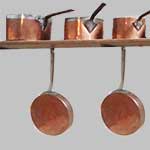Old cast iron and copper cooking pots and saucepans

Cooking pots in the early 20th century were made of cast iron or copper. They were not ideal, and this page discusses their shortcomings from the viewpoint of people using them and having to clean them afterwards.
____
Extracted from the memoirs of the webmaster's mother (1906-2002) and edited by the webmaster
The old cast iron and copper cooking pots in were heavy and did not have non-stick surfaces:
Cast iron cooking pots
The use of cast iron made pots very heavy. They usually had long handles, so that they could be lifted with two hands which was necessary but made them even more heavy.

Cast iron saucepan with its long handle
Cast iron was a good heat conductor, which was an advantage but it made the handles very hot in use. So they were normally held through a wrapped cloth.
Copper cooking pots

Copper cooking pots
Copper was an even better conductor of heat than cast iron. So copper pots could be made thinner than cast iron ones. This made them lighter and they cooked more quickly.
However, copper was much more expensive than cast iron. So it was mainly found in reasonably well-off homes, while cast iron continued its use in the houses of ordinary people.
Cleaning the pots
As there were no non-stick surfaces, it was very hard and time-consuming to clean a saucepan after use, as I remember to my cost.

Copper pots left to tarnish. If left too long, they look darker still.
To clean these old pots, we scraped off as much as we could, then used scouring powder (Vim or Ajax) and wire wool. It was very hard work and rather put us off cooking foods that stuck badly like scrambled egg. Only shortly afterwards rubber gloves became available. They helped the skin on our hands but didn't make the job any easier. (Scouring powder is seldom seen today, even though it was once an essential commodity. The reason must be that it must isn't necessary with non-stick coatings and would remove them anyway.

Scouring powder

Wire wool
I understand that in Victorian stately homes, scullery maids were expected to clean saucepans by rubbing sand into them with their bare finger tips!
Also, as copper tarnished, the scullery maids had to polish the outsides of the pots too! One of the photos shows well-polished copper pots while another shows one that is tarnished.
| sources | webmaster | contact |
Text and images are copyright
If you can add anything to this page or provide a photo, please contact me.



